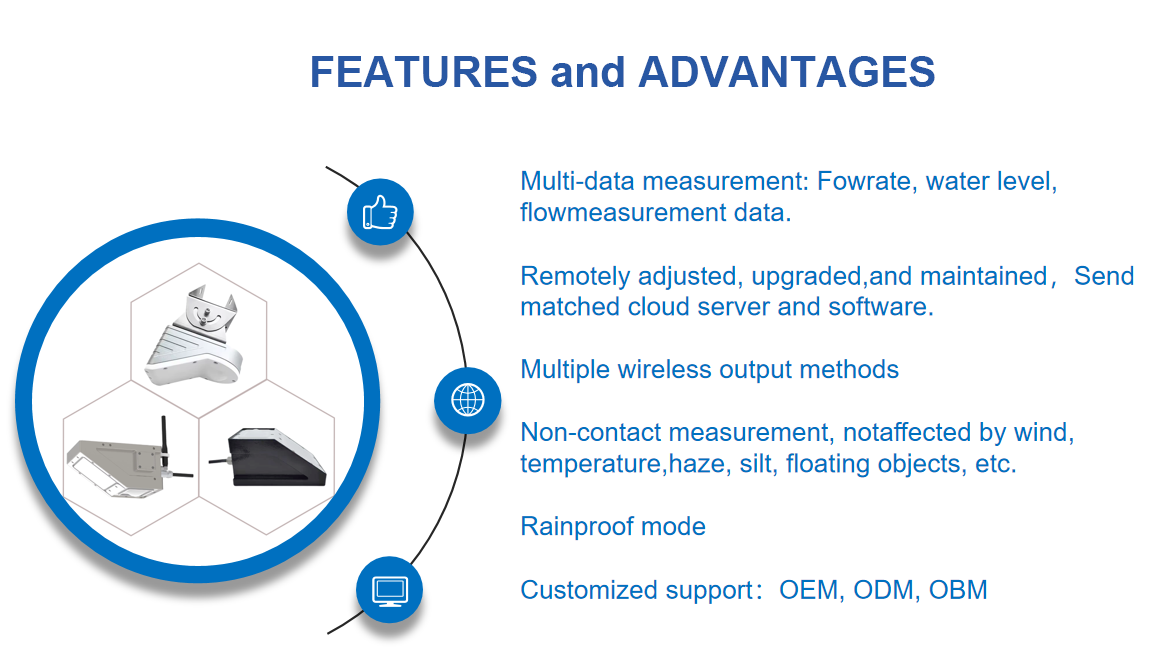1. Asalkii hore ee Farsamada: Nidaam Radar oo isku dhafan
"Saddex-in-One Hydrological Radar System" wuxuu caadi ahaan isku daraa hawlaha soo socda:
- Kormeerka Biyaha Dusha (Open Channels/Wabiyada): Cabbirka wakhtiga dhabta ah ee xawaaraha socodka iyo heerarka biyaha iyadoo la isticmaalayo dareemayaal ku salaysan radar.
- Kormeerka Dhuumaha Dhulka Hoostiisa: Ogaanshaha qulqulka, xannibaadaha, iyo heerarka biyaha dhulka hoostiisa iyadoo la adeegsanayo radar dhulka-musha (GPR) ama dareemayaasha codka.
- Kormeerka Badbaadada Biyo-xireenka: La socodka barokaca biyo-xireenka iyo cadaadiska jeexjeexyada iyada oo la adeegsanayo radar interferometry (InSAR) ama radar ku salaysan dhulka.
Waddamada kuleylaha ah, ee fatahaaduhu u nugul yihiin sida Indonesia, nidaamkani wuxuu wanaajiyaa saadaasha daadka, maareynta kheyraadka biyaha, iyo badbaadada kaabayaasha.
2. Codsiyada dhabta ah ee aduunka ee Indonesia
Kiiska 1: Nidaamka La socodka Daadka ee Jakarta
- Asal ahaan: Jakarta ayaa wajaheysa daadad joogto ah oo ay ugu wacan tahay webiyada buuxdhaafay (tusaale, wabiga Ciliwung) iyo nidaamyada biyo-mareenada gabowga.
- Tignoolajiyada la dabaqay:
- Furan Kanaalka: Mitirka socodka Raadaarka ee lagu rakibay hareeraha webiyada ayaa bixiya xogta waqtiga dhabta ah ee digniinta fatahaadda.
- Dhuumaha dhulka hoostiisa: GPR waxay ogaataa burburka tuubooyinka, halka AI ay saadaalisay khatarta xannibaadda.
- Natiijada: Digniinta daadadka hore waxay soo roonaadeen 3 saacadood xilliga monsoon 2024, taasoo kordhinaysa waxtarka wax ka qabashada xaaladaha degdegga ah 40%.
Kiiska 2: Maareynta Biyo-xireenka Jatiluhur (Galbeed Java)
- Asal ahaan: Biyo-xireen muhiim u ah waraabka, tamarta biyaha, iyo xakamaynta fatahaadaha.
- Tignoolajiyada la dabaqay:
- Kormeerka Biyo-xidheenka: InSAR waxay ogaataa cilladaha heerka millimitirka; seepage radar wuxuu tilmaamayaa socodka biyaha aan caadiga ahayn.
- Isku-dubbarididda Hoose: Xogta heerka biyaha ee ku salaysan Raadaarka ayaa si toos ah u habaysa irdaha biyo-xidheenka.
- Natiijada: Dhimista dhul-beereed ee fatahaaduhu saameeyeen 30% inta lagu jiro xilliga daadadka ee 2023.
Kiiska 3: Mashruuca Biyo-mareenka Wacan ee Surabaya
- Caqabada: Daadad daran oo magaalada ah iyo soo galitaanka biyaha cusbada.
- Xalka:
- Nidaamka Radar-isku-dhafka ah: Dareemayaasha waxay la socdaan qulqulka iyo qulqulka qulqulka ee marinnada qulqulka iyo tuubooyinka dhulka hoostiisa.
- Aragtida Xogta: Dashboards-ku-saleysan GIS waxay gacan ka geystaan wanaajinta hawlaha xarunta bamka.
3. Faa'iidooyinka iyo Caqabadaha
Faa'iidooyinka
✅ Kormeerka-waqtiga-dhabta ah: Cusbooneysiinta radar-ka-soo noqnoqda (heerka-daqiiqada) ee dhacdooyinka biyo-mareenada degdega ah.
✅ Cabbiraadda Xiriir La'aanta: Waxay ka shaqeysaa meelaha dhoobada ah ama dhirta leh.
✅ Daboolista Miisaanka Badan: La socodka aan kala go 'lahayn ee korka ilaa dhulka hoose.
Caqabadaha:
⚠️ Qiimaha Sare: Nidaamyada radar-ka horumarsan waxay u baahan yihiin iskaashi caalami ah.
⚠️ Isku-dhafka Xogta: Waxay u baahan tahay isku-dubarid hay'ado ka dhexeeya (biyaha, degmada, maareynta musiibada).
Fadlan la xiriir Honde Technology Co., Ltd.
Email: info@hondetech.com
Mareegta shirkadda:www.hondetechco.com
Tel: +86-15210548582
Waqtiga boostada: Jul-16-2025


